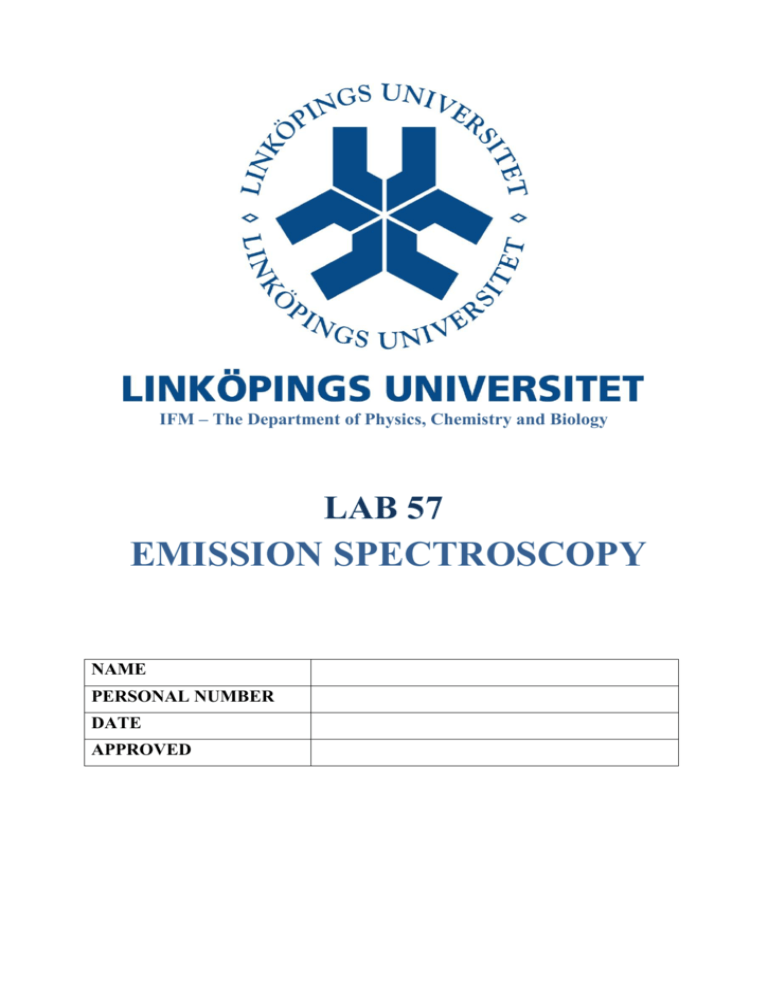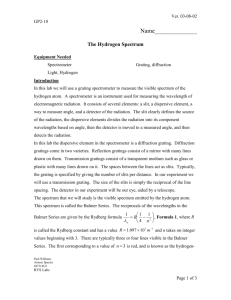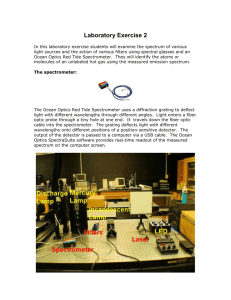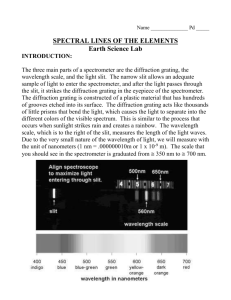Emission spectrum
advertisement

IFM – The Department of Physics, Chemistry and Biology LAB 57 EMISSION SPECTROSCOPY NAME PERSONAL NUMBER DATE APPROVED I. OBJECTIVES - Understand the principle of atomic emission spectra. - Know how to acquire the spectra and identify the specific spectra of some common materials. - Figure out the advantages and the disadvantages of this technique. II. BACKGROUND 1. Bohr’s model According to Bohr’s model, an atom consists of electrons which resolve around the nucleus in certain orbits corresponding to each discrete energy level. The restricted angular momentum of an electron is described as the following equation: (1) Where n is principle quantum number (n = 1, 2, 3, 4,…), h is Plank constant and The transition of an electron from the higher level to the lower level will emit a photon and vice versa, a photon will be absorbed. The wavelength of the emitted/absorbed radiation (photon) is directly related to the difference between two energy levels (or two states): (2) Where is the frequency of radiation, E2 is the high energy level, E1 is the low energy level. E E2 Absorbed photon Emitted photon E1 FIG. 1. Transition of an electron between two states FIG. 2. Bohr’s model Each atom of element has its own discrete energy levels which gives rise to its characteristic emitted/absorbed radiation. This special feature is used as a fingerprint to identify the presence of the elements. 2. Atomic emission 2.1. Principle: Any method that adds heat in any way to the sample can be used to generate the spectrum. When we heat the sample, atoms will be excited and then the relaxation of atoms will emit visible light which has the color depending on the element. In order to separate the light into constituent composition, a disperse component such as prism, grating is used. The dispersed light is detected and recorded by detectors then the spectrum is shown in a computer display. FIG. 3. Set up for recording the atomic emission spectrum of Hydrogen FIG. 4. The flame tests above show (a) strontium, (b) sodium, (c) lead, and (d) potassium. FIG. 5. The emission spectrum of calcium (up) and sodium (bottom) Source: http://imagine.gsfc.nasa.gov/docs/teachers/lessons/xray_spectra/student-worksheetflame.html 2.2. Experiment methods An emission spectroscopic analysis can be divided into three basic steps as illustrated below: a. Excitation For gaseous and liquid samples absorption spectrometry are most commonly used with a deuterium arc lamp for short wavelengths and a halogen lamp for longer wavelengths. For solid sample, three below methods are commonly used: * Flame: Most commonly used to analyse alloys today is to dissolve the alloy in an acid and inject the liquid into a flame. This flame can be ether an acetyleneoxygen flame or an induction heated argon flame * DC arc: An electric discharge is another method that has been commonly used, and is used in this laboratory exercise. Then a DC-current can be utilized, where a large number of atoms are excited during a long time at a temperature of about 5000K. A drawback then is that the arc may wander around on the sample so that the light becomes outside the focus of the spectrometer used. The reproducibility of the measurements is then low. * AC spark: Another method is to use a resonant LC-circuit that generates a high frequency oscillation when a spark is initialized. The LC-circuit is only charged with a few thousand volts which is not enough to initialize a spark on its own so there is an additional low energy high voltage circuit carrying some 20000 volts that strikes the spark at regular intervals. This arrangement is capable of generating very high currents for short time periods and the temperature in the spark can reach 10000K. This high temperature excites electrons to higher energy levels and the spectrum then contains many more lines for electron de-excitations to higher energy levels than the ground state. One drawback is that the total energy is lower than DC-arc excitation and the intensity of the spectral lines are lower. How to choose a suitable method? The suitable method depends on our purpose and facility, of course. If one wants to analyse trace elements present in a sample the DC-arc method is the preferred one, if one wants to analyze the exact composition of an alloy the AC-spark method would be the preferred method. The high voltage generator used here is oh the DC-arc type. b. Dispersion Two common methods used to disperse the light before arriving at the detector are prism and diffraction grating. Using prism is quite simple than grating but the resolution is limited. That’s why for measurement requiring a highly exact analysis, the diffraction grating is preferred. The reflection grating is a very important part in a monochromator which used to limit the wavelength of the light introduced to the photodetector. In the case of reflection grating, the relation between the incident angle, reflection angle, wavelength, grating period is described as the following equation: ( ) ( ) ( ) d: spacing between the slits, called the grating period N: number of slits per mm (the groove density), equal to the reciprocal of the grating period (grooves or lines/mm) m: order of deflection (m = 0, ±1, ±2, ±3,…) λ: wavelength It can be seen that when m ≠ 0 the reflection angle is different for each wavelength. Therefore, we can use gratings to separate (disperse) white light into its constituent wavelengths. The diffraction angle ß also varies with the groove density N and the incident angle α. Depending on the value of N, the deflection light may be not obtained. For example, if the incident angle α = 30° and the groove density N = 2400 grooves/mm and the wavelength of 700 nm, using the equation (4) with m = 1 (fisrt order of deflection), we get (as we know, it should be always less than 1). Thus, there is no first-order reflection FIG. 6. The Principle of Reflection Gratings light in this case. In our experiment, rotating the grating makes the incident angle and the reflection angle change, thereby the wavelength range recorded by a detector changes. The grating can be rotated to cover different parts of the spectrum which is useful to monitor the entire spectrum. With the 1200 lines / mm grating 10 μm translates to a 1 nm wavelength shift. When using the 1200 lines / mm grating a smaller energy interval is available but at a higher resolution compared to the 600 lines / mm grating. c. Detection The intensity at different wavelengths is detected by a PDA (Photo Diode Array), see in Fig. 8., which is a component similar to the CCD used in modern digital cameras. In this case it is an array of 1024 insulated photo diodes that each accumulates a charge proportional to the number of photons that hits them. When a photon strikes a semiconductor, it can excite electron from the valance band to the conduction band which results in an electron-hole pair, see in Fig. 7. The concentration of these electron-hole pair depends on the amount of photons striking the semiconductor. Through the voltage on each photodiode, we can determine the amount of the electron-hole pairs and thereby the intensity of light. A 12bit A/D converter scans the voltages over the diodes and removes the accumulated charge. This scanning is done continuously by the control electronics connected to the spectrometer and only when a command is given to the computer the data is read into the computer. FIG. 7. Schematic of semiconductor detector FIG. 8. 46 element Si photodiode (http://www.files.chem.vt.edu/chemed/optics/detector/pd.html) array for UV to NIR III. PREPARATORY ASSIGNMENTS 1. Assignment 1 Describe the Bohr’s model 2. Assignment 2 (excitation) In the compendium three procedures to evaporate and excite a sample are described. Name them? When is one or the other method used? 3. Assignment 3 (dispersion) Two methods for wavelength separation are described. Which? Which one of the two do you think is most used today? 4. Assignment 4 (diffraction) In first order diffraction of light of wavelength λ diffracted at 450 with the normal and follows the laws of reflection. The grating consists of 1200 lines/mm. What will be the wavelength of light in nm? 5. Assignment 5 (Photodiode array) Describe in short by diagram function of PDA. 6. Assignment 6 Give conversion steps to convert energy in eV into Å wavelength. 7. Assignment 7 Describe with in a line, the role of slit, grating and PDA of a spectrometer. IV. EXPERIMENT 1. Acquire the background spectrum Turn off the light Select Sampling from the Setup, then set up the two parameters: integration time (ms):100 and averaging: 1 Select Mode Spectrum Pixels (in box X-units) Click button to acquire the spectrum Observe the spectrum, then save the spectrum. 2. Acquire the spectrum of Hg Set-up the lamp, mirror, lense and spectrometer as the figure below: Mirror Lens Spectrometer Hg Lamp Computer light Connect the Hg lamp to the source. Open the program “SpectraArray SL” (on the desktop). Select Sampling from the Setup, then set up the two parameters: integration time (ms):100 and averaging: 1 Select Mode Spectrum Pixels (in box X-units) Click button to acquire the spectrum Adjust the angle of mirror until the count of the strongest peak around 3400. Click button again to stop the measurement and capture the spectrum used for analysis. Notice: The y-axis shows the intensity, the x-axis shows the peak position in pixel unit NOT in wavelength unit (Å, nm) 3. Calibration In principle, calibration process includes three main steps as mentioned below: Step 1: Measure the emission spectrum of a standard spectral lamp within the relevant selected spectral range in which strong peaks appear. In our experiment, we use a Hg lamp as a standard lamp. Step 2: Identify the peak position in a unit of pixel along the X-axis. Notice: choose the maximums of spectral lines to avoid noise. Step 3: Correlate them with the reference data taken from NIST atomic spectra database or hand book. In our measurement, we will use the manual calibration. Step 1: Acquire the Hg spectrum Step 2: Determine the pixel position of the high peaks in a whole spectrum. Step 3: Using NIST database or Handbook to determine the wavelength of each peak. Tip: You should draw two columns to write down the pixel position and the corresponding wavelength. Pixel Wavelength Position … … … Hg lamp is often used for calibrating when we study the peaks in visible range, see Fig. 9. For higher range of wavelength, Ne lamp is a preferred one. Three strong and clear peaks sufficiently give a good calibration The wavelength region can be changed by altering the grating position which is done by turning the micrometer (in our lab, we do not need to change this parameter) FIG. 9. The atomic emission spectrum of the mercury arc lamp (http://zeiss-campus.magnet.fsu.edu/articles/basics/fluorescence.html) Step 4: Click Setup Wavelength Calibration Calibrate using spectral lines Add Fill the pixel position (from an acquired spectrum) and the corresponding wavelength (from NIST database of Hg I) of each peak used to calibrate. Step 5: Select Accept button to complete calibration. Step 6: Change unit of x-axis by selecting Mode Spectrum nm (in box Xunits) 4. Analysis of spectra of some other lamps: Ne, Na Step 1: Replace the Hg lamp by the Ne or Na lamp. Step 2: Turn on the lamp and acquire the spectrum Step 3: Determine the wavelength of each characteristic peak by moving mouse cursor to each peak. Step 4: Compare with the standard database to see how good the spectrum is. If not good, we have to calibrate more by adding some known peaks. Notice: Almost peaks of Ne lamp appear in the infrared range. Therefore, some peaks above 700 nm cannot be seen in the spectrum. Of course, we can see the whole spectrum by adjusting the mirror of the spectrometer. However, we have to calibrate again. Remember: Adjusting mirror means calibrating again, so don’t do it. 4. Analysis of solid material (Copper, Zinc, Steel, Spoon and some coins) Step 1: Sharpen the carbon electrode by a pencil sharpener and polish the surface of analyzed material. Step 2: Load the carbon electrode (top) and the material (bottom) to DC-arc system. Remember the distance between the electrode and the material must be small (~ 2 mm) Step 3: Turn on the DC-source Step 4: Press the black button (on the left of the DC source) to initialize the arc. If no arc appears, we need to check the electrode and the material again (The distance is OK or not, the electrode is sharp or not…). Step 5: When the arc appears, we have to acquire the spectrum quickly then shut down the DC-source (just open the door of chamber) to protect the electrodes from melting. Step 6: Analyze the acquired spectrum. Notice: Never keep the arc appear for more than 10s. It can make the electrode melt. When the arc initiates, immediately adjust the distance, the angle of the lens to focus the light on the entrance slit to have a sufficiently high peak on the screen. After that, we have acquire the spectrum and shut down the arc. V. GUILDLINES Make a proper protocol so you can keep track of what tests have done. Verify that the parameters used by the computer are the same as the spectrometer is set to. Clean and sharpen the electrodes and adjust the electrode gap before every measurement. Do not touch the electrodes while they carry voltage. Do not look directly into the arc. UV-light fogs the lens in your eye. Verify that the light is well collimated on the slit before your run the command scan. Make use of tables or spectral atlases to find suitable candidates for elements present in the samples and eliminate some by exclusion (if one spectral line is missing the candidate is probably not present in the sample). Note that a sample usually contains more than one element. Use and update the calibration curve present in the lab. Do not hurry, you have enough time.








